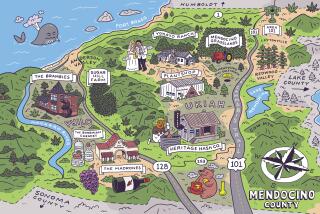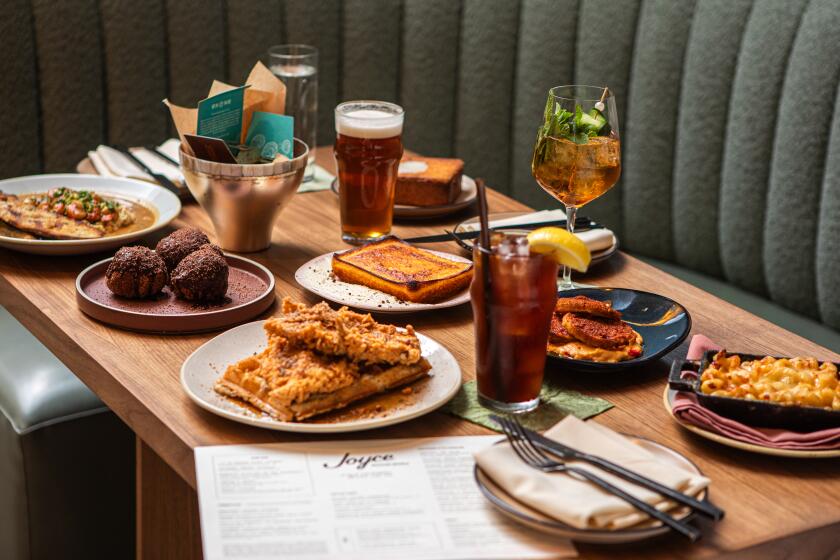Rocky Mountain High
PALISADE, Colo. — At 6,400 feet above sea level, Terror Creek Winery has one of the world’s highest vineyards. I had heard that it also has one of the most spectacular settings in the world for a commercial winemaking concern, so my wife and I went out of our way to see it on a tour of western Colorado’s wine country.
Terror Creek Winery is in the expanded root cellar of a former cattle ranch overlooking a valley of orchards and hay fields. On sloped ground just below the winery’s shady lawn is its small vineyard, and rising shoulder-to-shoulder across the valley are three magnificent mountains: Landsend Peak, Mt. Lamborn and Coal Peak. Their sky-piercing heights were marbled with snow when my wife, Maria Luisa, and I took in the panorama on a very warm afternoon late in June. Yes, spectacular.
Maria Luisa is from central Chile, which has a benign Mediterranean climate and a long tradition of winemaking. She doubted that grapes grown in this often snowbound state could be turned into anything very good. Impossible, she said.
*
Although I am a native Coloradan, I tended to agree. I had lived out of the state for many years, and before moving back in 1996, I wasn’t even aware that a small wine industry had been developing here, on the Western Slope of the Rockies. (Terror Creek is one of 21 wineries in the state now fermenting Colorado-grown grapes.)
Then I ran across a 1997 book, “The Guide to Colorado Wineries,” by Alta and Brad Smith. It convinced me that something interesting was happening around Grand Junction, in the towns of Palisade, Delta and Paonia. Curious, I bought a bottle of Palisade red. I’m not a connoisseur, but it didn’t take an educated palate to judge this wine thin, acid, hard with tannin. “No me gusta,” Maria Luisa agreed.
Then a friend gave us another bottle from the same winery, and this one seemed much better. Dry but fruity and fresh. Maria Luisa said it was OK, but without much enthusiasm. I was going to buy some more, but I decided instead that we should take a two-day trip to tour the wineries, see the vineyards and sample the wines. I especially hoped that Colorado wines would be able to win over the skeptical Maria Luisa.
Interstate 70, Colorado’s main east-west route, goes right through Palisade, about 240 miles west of the Denver area, where we live, so it didn’t take a lot of map work to figure out how to get there.
Palisade sits on the Colorado River at the foot of a long, barren bluff of crumbling rock that rises nearly 2,000 feet above the town. It’s called the Bookcliff because early explorers thought its weathered, angular features looked like a shelf of books. East of Palisade, rising even higher, is the Grand Mesa, which local tourist literature calls the highest flat-top mountain in the world (about 10,000 feet above sea level). Its steep, soaring face makes an imposing backdrop for the orchards and vineyards that spread from Palisade south in the Grand Valley.
Our first stop in Palisade was Plum Creek Cellars, nestled in one of its own vineyards on the east side of town. The winery, which opened in 1990, was already building a bigger tasting room to accommodate its growing stream of visitors. (The Colorado Wine Industry Development Board expects 50,000 visitors to the area this year.) After sampling a few of Plum Creek Cellars’ wide variety--Chardonnay, Merlot, Cabernet Sauvignon, Sauvignon Blanc, Pinot Noir, Cabernet Franc and Riesling--we bought a bottle of 1995 Cabernet Franc for $8.99 to take home.
Colorado might seem an unlikely place for vineyards, but the Grand Valley--protected by the Bookcliff and the Grand Mesa--offers a surprisingly appropriate microclimate of generally mild winters and warm, dry summers that has long been recognized as ideal for such fruits as cherries, peaches and apples.
Grapes, too, were one of the area’s main fruit crops after it was settled in the 1880s. But in 1916, the Colorado Legislature pulled the plug on the state’s winemakers by banning alcoholic beverages, four years before national Prohibition began. Not until 1968 did commercial winemaking resume. And even by 1980, Colorado had only two wineries.
*
Today, Colorado wineries are all still small, often operated by couples pursuing second careers after making wine as a hobby. They are likely to be found in their tasting rooms, greeting visitors, pouring samples, talking fondly about the liquid love of their lives.
And so it was when we stopped at Carlson Vineyards. Owners Mary and Parker Carlson were behind a table full of open bottles, talking to visitors. Parker Carlson told us how he started by making hard cider at home and moved on to making wine in 5-gallon glass carboys, then in stainless steel beer kegs.
“Then I started making it in 55-gallon plastic drums, and that’s when Mary started getting upset because she had no room in the house,” he said.
The Carlson Vineyards wines are unpretentious, some with such whimsical names as Prairie Dog White and Tyrannosaurus Red. After trying a few, we bought an $8 bottle of the 1995 Tyrannosaurus Red, a blend of Merlot, Pinot Noir, Lemberger and Pinot Gris.
It was time to check in and freshen up at the Orchard House, a B&B; where we had a reservation for the night. We had an upstairs suite with a view of the Bookcliff and, in the morning, a bountiful breakfast.
Stephanie Schmid, the owner, said that some guests include a winery tour in a circuit of nearby sights, such as the sculptured canyons of Colorado National Monument, the forested heights of the Grand Mesa and Arches National Park in Utah, about a 90-minute drive west.
The largest grape grower in Colorado, with about 60 acres, is Grande River Vineyards, which has its winery on the north side of Palisade, where the Bookcliff looms above like a wall built by ancient giants. Grande River plants and ferments some lesser known varieties, including Viognier and Syrah, along with more familiar ones. After tasting some of them, we settled on a $13 bottle of the 1994 Meritage.
“People just don’t imagine that there could be wine grown in Colorado, particularly pretty good wine,” co-owner Stephen Smith said. By this time, Maria Luisa had overcome her Chilean prejudice and was a believer.
We could have dined at the Orchard House, but we wanted to see a little of Grand Junction, a small city 10 miles away, so we decided to look around there for a place to eat. We had heard about several popular spots, and we ended up indulging a desire for Mexican food in a simple family restaurant named Los Reyes. We probably would have had better fare at the Orchard House, but we had a nice evening drive around the city.
Back at the Orchard House, we sat in rockers on the south porch while the day’s last light slipped away to the west over the silhouette of the Bookcliff. Crickets and toads made music.
The Bookcliff, dazzling in the morning light, was spread across our south windows when we woke up the next day. Downstairs, the innkeeper offered us several options for breakfast, and we both chose frittata, a kind of omelet stuffed with mushrooms, zucchini and cheese.
*
We began our day’s exploring with a drive around the zigzagging lanes of East Orchard Mesa south of town, stopping at a couple of fruit stands.
Bing and Lambert cherries were deliciously ripe when we were there in June. The Grand Valley’s peaches are ripe from late July through August, plums from early August through mid-September, pears from mid-August to mid-September and apples from mid-September through October. Grapes are harvested in September and October.
After a visit to Colorado Cellars, the only winery in the state that makes champagne- and Port-style wines, we were ready for lunch. There aren’t a lot of restaurants to choose from in Palisade. We decided on the Sandrock Mesa Restaurant and Lounge, where Rocky Mountain oysters, sliced, breaded and fried, were on the menu. They turned out to be a little overdone but tasty.
The restaurant’s wine list included several Colorado labels that we were now familiar with, but it was early in a hot afternoon and we had a lot of driving to do, so we drank clean-tasting Palisade water.
Our destination was Terror Creek Winery in Paonia, on the far (south) side of the Grand Mesa. There are two ways to get there from Palisade (and I-70). The direct route is south through the relatively straight and flat valley along the Gunnison River to the town of Delta, then east to Paonia. The longer way, which we were told would take half an hour more, was up over the Grand Mesa and down into Paonia. We took the high road.
It was a memorable two hours. The road, called the Grand Mesa Scenic Byway (Colorado Highway 65), first winds up through a narrow canyon of jagged cliffs and overhangs carved by water over the ages. Then it climbs to the top of the mesa through spruce forests splashed with blue lakes. We stopped three or four times to take in the majestic views down toward the Grand Valley and beyond.
Terror Creek Winery, owned by Joan and John Mathewson, is at the end of a dirt road about two miles northwest of Paonia. After we had sat for a while on the shady lawn facing Landsend, Lamborn and Coal Peak, Joan invited us into the small tasting room to try some of the wines she learned to make while earning her diploma at a vintners’ school in Switzerland. We especially liked the Gewurztraminer.
The wine, the view, the sense of seclusion--Terror Creek Winery was worth the extra miles.
(BEGIN TEXT OF INFOBOX / INFOGRAPHIC)
GUIDEBOOK
Wine Line in Colorado
Getting there: Delta has connecting service daily from LAX through Salt Lake City to Grand Junction on Sky West. United has connecting service daily from LAX through Denver to Grand Junction on United Express. Fares begin at $198 round trip.
Where to stay: The Orchard House, 3573 E 1/2 Road, Palisade, CO 81526; telephone (970) 464-0529; fax (970) 464-0681; e-mail oliver@iti2.net; doubles $60 to $75. The Garden House, 3587 G Road, Palisade, CO 81526; tel. (970) 464-4686 or (800) 305-4686; doubles $65 to $79. Several chain hotels are in Grand Junction.
Where to sip: Palisade has an annual wine festival. This year it will be Sept. 19, preceded by a bicycle tour of local wineries.
The following wineries are open daily year-round unless noted otherwise.
Carlson Vineyards, 461 35 Road, Palisade, CO 81526; tel. (970) 464-5554.
Colorado Cellars, 3553 E Road, Palisade, CO 81526; tel. (970) 464-7921 or (800) 848-2812; closed Sunday.
Grande River Vineyards, 787 Elberta Ave., Palisade, CO 81526; tel. (970) 464-5867.
Plum Creek Cellars, 3708 G Road, Palisade, CO 81526; tel. (970) 464-7586.
Rocky Mountain Meadery and Cidery, 3701 G Road, Palisade, CO 81526; tel. (970) 464-7899.
Terror Creek Winery, 1750 4175 Drive, Paonia, CO 81428; tel. (970) 527-3484; open Friday through Sunday, Memorial Day through Labor Day.
For more information: Colorado Wine Industry Development Board, 3168 B 1/2 Road, Grand Junction, CO 81503; tel. (970) 523-1232; fax (970) 434-1035.
Colorado Travel and Tourism Authority, P.O. Box 22005, Denver, CO 80222; tel. (800) 433-2656.
More to Read
Eat your way across L.A.
Get our weekly Tasting Notes newsletter for reviews, news and more.
You may occasionally receive promotional content from the Los Angeles Times.










